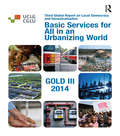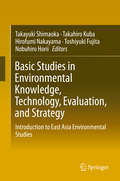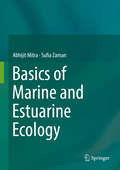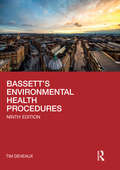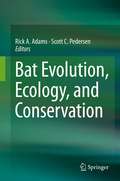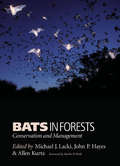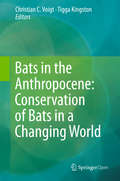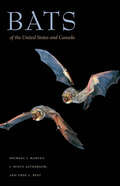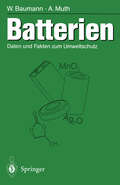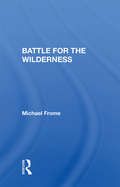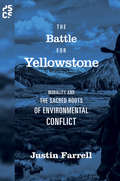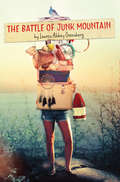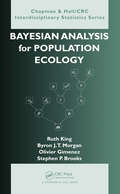- Table View
- List View
Basic Income for Disasters and Climate Change in Africa: Agrarian Risk Reduction and Adaptation (Routledge Studies in African Development)
by Sara BernardoThis book considers how basic income could be used as a mechanism for disaster risk reduction and climate change adaptation in African agrarian societies.African agrarian societies are among those most severely impacted by disasters due to insufficient financial and technological resources to prepare for and respond to crises. This book argues that hazards and environmental disasters are increasingly not isolated occurrences, and the vulnerability of communities is cumulative event after event, with capacities to cope and adapt weakened progressively. With pre- and post-disaster operating as a single continuous process, basic income could provide communities with a stable flow of money, leaving them better able to adapt and respond to crises. To illustrate the theoretical framework, the book uses Mozambique, and more specifically the district of Búzi, as an instrumental case study.This innovative book will be of interest to readers across the fields of global development, African studies and humanitarian and disaster studies.
Basic Services for All in an Urbanizing World
by United Cities And Local Governments StaffUCLG’s Third Global Report on Local Democracy and Decentralization (GOLD III) examines basic service provision and the current state-of-play of the local governance of basic services around the world. Basic Services for All in an Urbanizing World examines the enormous challenge of ensuring the universal provision of basic services in a world that is being shaped by rapid global urbanization, climate change, and economic, social and technological transformation. The world’s urban population is predicted to reach 5 billion people within the next 20-30 years. The report analyses the conditions necessary for local governments to provide these new urban residents with quality basic services. Water, sanitation, waste management, transport and energy are essential, not only for the preservation of human life and dignity, but also in driving economic growth and ensuring social equality. Each chapter examines a world region, drawing on existing research and consultation with local authorities on the ground. The chapters review access levels, legal and institutional frameworks, and the different ways in which basic services are managed and financed, as well as showcasing diverse examples of innovation in the local and multi-level governance of services. It concludes with a set of recommendations for all stakeholders with a view to making the goal of basic services for all a reality. This report contributes to discussions on the Millennium Development Goals and the UN Post-2015 Development Agenda. The findings of GOLD III will also be essential to promoting the vision of local governments at the 2016 UN Conference on Human Settlements (Habitat III).
Basic Services for All in an Urbanizing World
by UclgUCLG’s Third Global Report on Local Democracy and Decentralization (GOLD III) examines basic service provision and the current state-of-play of the local governance of basic services around the world. Basic Services for All in an Urbanizing World examines the enormous challenge of ensuring the universal provision of basic services in a world that is being shaped by rapid global urbanization, climate change, and economic, social and technological transformation. The world’s urban population is predicted to reach 5 billion people within the next 20-30 years. The report analyses the conditions necessary for local governments to provide these new urban residents with quality basic services. Water, sanitation, waste management, transport and energy are essential, not only for the preservation of human life and dignity, but also in driving economic growth and ensuring social equality. Each chapter examines a world region, drawing on existing research and consultation with local authorities on the ground. The chapters review access levels, legal and institutional frameworks, and the different ways in which basic services are managed and financed, as well as showcasing diverse examples of innovation in the local and multi-level governance of services. It concludes with a set of recommendations for all stakeholders with a view to making the goal of basic services for all a reality. This report contributes to discussions on the Millennium Development Goals and the UN Post-2015 Development Agenda. The findings of GOLD III will also be essential to promoting the vision of local governments at the 2016 UN Conference on Human Settlements (Habitat III).
Basic Studies in Environmental Knowledge, Technology, Evaluation, and Strategy: Introduction to East Asia Environmental Studies
by Takayuki Shimaoka Takahiro Kuba Hirofumi Nakayama Toshiyuki Fujita Nobuhiro HoriiThis book covers diverse environmental issues such as climate change; biodiversity preservation; prevention of air, water, and soil pollution; and resource recycling. Readers can acquire these four practical interdisciplinary abilities: 1. knowledge; 2. technology; 3. evaluation; and 4. strategy in the diverse issues related to the environment. These abilities are fundamental to identifying the core essence of economic and ecological interdependence, to look at and analyze problems from an overarching perspective, and to consider countermeasures to be taken. Each chapter of this book corresponds to a lecture in the East Asia Environmental Strategist Training Program at Kyushu University and is excellent reading as a sourcebook.
Basics of Marine and Estuarine Ecology
by Abhijit Mitra Sufia ZamanThe book presents recent research on marine ecology in different parts of the world. It aims to shed light on relevant topics for budding marine ecologists.The “blue soup” of Planet Earth, which comprises both biotic and abiotic components, is essential to keeping the wheel of civilization running. Four major ecosystem service categories have been identified within this context, namely provisioning services such as water, food, mangrove timber, honey, fish, wax, fuel wood, fodder and bioactive compounds from marine and estuarine flora and fauna; regulating services such as the regulation of climate, coastal erosion, coral bleaching and pollution; cultural services encompassing recreational (tourism), spiritual and other non-material benefits; and supporting services such as nutrient cycling and photosynthesis. These valuable services are obtained from various resources that must be conserved for the sake of humanity. This book presents data for each resource type, not just in the form of a simple description, but also through case studies that resulted from several research projects and pilot programs carried out in different parts of the world. Statistical tools were also used to critically analyze the influence of relevant hydrological parameters on the biotic community. Advanced research in marine and estuarine ecology is based on the use of sophisticated instruments, sampling precision, statistical tools, etc., which have also been highlighted in the book.
Bassett's Environmental Health Procedures
by W.H. Bassett Tim DeveauxEnvironmental health law is a wide-ranging, detailed and complex body of law within the UK. Bassett’s Environmental Health Procedures is an established and essential reference source which provides an accessible entry into enforcement and administrative procedures for environmental health. The main legal procedures used in the environmental health field are presented as flow charts supported by explanatory text. This ninth edition refines the structure introduced in the eighth edition, with each chapter addressing a single topic. It has introduced the titles of the corresponding legislation in Scotland and Northern Ireland where there is such legislation. The book has been updated throughout to reflect new practices, legislation and statutory guidance. Specifically, the ninth edition contains new content on Antisocial Behaviour and significant updates to sections on: Enforcement and Administration Environmental Protection Food Safety Housing and Public Health Environmental Health Officers/Practitioners and students will find this book invaluable. It will also be an essential reference for all those whose responsibilities demand they keep abreast of current environmental health practices.
Bassett's Environmental Health Procedures
by W.H. Bassett Tim DeveauxEnvironmental health law is a wide-ranging, detailed and complex body of law within the UK. Bassett’s Environmental Health Procedures is an established and essential reference source which provides an accessible entry into enforcement and administrative procedures for environmental health. The main legal procedures used in the environmental health field are presented as flow charts supported by explanatory text. This ninth edition refines the structure introduced in the eighth edition, with each chapter addressing a single topic. It has introduced the titles of the corresponding legislation in Scotland and Northern Ireland where there is such legislation. The book has been updated throughout to reflect new practices, legislation and statutory guidance. Specifically, the ninth edition contains new content on Antisocial Behaviour and significant updates to sections on: Enforcement and Administration Environmental Protection Food Safety Housing and Public Health Environmental Health Officers/Practitioners and students will find this book invaluable. It will also be an essential reference for all those whose responsibilities demand they keep abreast of current environmental health practices.
Bat Evolution, Ecology, and Conservation
by Rick A. Adams and Scott C. PedersenRecent advances in the study of bats have changed the way we understand this illusive group of mammals. This volume consist of 25 chapters and 57 authors from around the globe all writing on the most recent finding on the evolution, ecology and conservation of bats. The chapters in this book are not intended to be exhaustive literature reviews, but instead extended manuscripts that bring new and fresh perspectives. Many chapters consist of previously unpublished data and are repetitive of new insights and understanding in bat evolution, ecology and conservation. All chapters were peer-reviewed and revised by the authors. Many of the chapters are multi-authored to provide comprehensive and authoritative coverage of the topics.
Bats in Forests: Conservation and Management
by John P. Hayes Allen Kurta Michael J. LackiAlthough bats are often thought of as cave dwellers, many species depend on forests for all or part of the year. Of the 45 species of bats in North America, more than half depend on forests, using the bark of trees, tree cavities, or canopy foliage as roosting sites. Over the past two decades it has become increasingly clear that bat conservation and management are strongly linked to the health of forests within their range. Initially driven by concern for endangered species—the Indiana bat, for example—forest ecologists, timber managers, government agencies, and conservation organizations have been altering management plans and silvicultural practices to better accommodate bat species. Bats in Forests presents the work of a variety of experts who address many aspects of the ecology and conservation of bats. The chapter authors describe bat behavior, including the selection of roosts, foraging patterns, and seasonal migration as they relate to forests. They also discuss forest management and its influence on bat habitat. Both public lands and privately owned forests are considered, as well as techniques for monitoring bat populations and activity.The important role bats play in the ecology of forests—from control of insects to nutrient recycling—is revealed by a number of authors. Bat ecologists, bat conservationists, forest ecologists, and forest managers will find in this book an indispensable synthesis of the topics that concern them.
Bats in the Anthropocene: Conservation of Bats in a Changing World
by Christian C. Voigt Tigga KingstonThis book focuses on central themes related to the conservation of bats. It details their response to land-use change and management practices, intensified urbanization and roost disturbance and loss. Increasing interactions between humans and bats as a result of hunting, disease relationships, occupation of human dwellings, and conflict over fruit crops are explored in depth. Finally, contributors highlight the roles that taxonomy, conservation networks and conservation psychology have to play in conserving this imperilled but vital taxon.With over 1300 species, bats are the second largest order of mammals, yet as the Anthropocene dawns, bat populations around the world are in decline. Greater understanding of the anthropogenic drivers of this decline and exploration of possible mitigation measures are urgently needed if we are to retain global bat diversity in the coming decades. This book brings together teams of international experts to provide a global review of current understanding and recommend directions for future research and mitigation.
Bats of the United States and Canada
by Michael J. Harvey J. Scott Altenbach Troy L. BestThe only mammals capable of true flight, bats are among the world’s most fascinating creatures. This accessible guide to the forty-seven species of bats found in the United States and Canada captures and explains the amazing diversity of these marvels of evolution.A wide variety of bat species live in the United States and Canada, ranging from the California leaf-nosed bat to the Florida bonneted bat, from the eastern small-footed bat to the northern long-eared bat. The authors provide an overview of bat classification, biology, feeding behavior, habitats, migration, and reproduction. They discuss the ever-increasing danger bats face from destruction of habitat, wind turbines, chemical toxicants, and devastating diseases like white-nose syndrome, which is killing millions of cave bats in North America. Illustrated species accounts include range maps and useful identification tips. Written by three of the world’s leading bat experts and featuring J. Scott Altenbach's stunning photographs, this fact-filled and easy-to-use book is the most comprehensive and up-to-date account of bats in the U.S. and Canada.
Bats of the United States and Canada
by Michael J. Harvey J. Scott Altenbach Troy L. BestThe only mammals capable of true flight, bats are among the world’s most fascinating creatures. This accessible guide to the forty-seven species of bats found in the United States and Canada captures and explains the amazing diversity of these marvels of evolution.A wide variety of bat species live in the United States and Canada, ranging from the California leaf-nosed bat to the Florida bonneted bat, from the eastern small-footed bat to the northern long-eared bat. The authors provide an overview of bat classification, biology, feeding behavior, habitats, migration, and reproduction. They discuss the ever-increasing danger bats face from destruction of habitat, wind turbines, chemical toxicants, and devastating diseases like white-nose syndrome, which is killing millions of cave bats in North America. Illustrated species accounts include range maps and useful identification tips. Written by three of the world’s leading bat experts and featuring J. Scott Altenbach's stunning photographs, this fact-filled and easy-to-use book is the most comprehensive and up-to-date account of bats in the U.S. and Canada.
Battle For The Wilderness
by Michael FromeThis book focuses on the principles of wilderness, exploring the actual and potential values of wilderness, its ecology, economics, the effect of human impact, and mechanisms to protect small, relatively untouched tracts in or near urban areas in the United States.
Battle For The Wilderness
by Michael FromeThis book focuses on the principles of wilderness, exploring the actual and potential values of wilderness, its ecology, economics, the effect of human impact, and mechanisms to protect small, relatively untouched tracts in or near urban areas in the United States.
The Battle for Yellowstone: Morality and the Sacred Roots of Environmental Conflict
by Justin FarrellYellowstone holds a special place in America's heart. As the world's first national park, it is globally recognized as the crown jewel of modern environmental preservation. But the park and its surrounding regions have recently become a lightning rod for environmental conflict, plagued by intense and intractable political struggles among the federal government, National Park Service, environmentalists, industry, local residents, and elected officials. The Battle for Yellowstone asks why it is that, with the flood of expert scientific, economic, and legal efforts to resolve disagreements over Yellowstone, there is no improvement? Why do even seemingly minor issues erupt into impassioned disputes? What can Yellowstone teach us about the worsening environmental conflicts worldwide?Justin Farrell argues that the battle for Yellowstone has deep moral, cultural, and spiritual roots that until now have been obscured by the supposedly rational and technical nature of the conflict. Tracing in unprecedented detail the moral causes and consequences of large-scale social change in the American West, he describes how a "new-west" social order has emerged that has devalued traditional American beliefs about manifest destiny and rugged individualism, and how morality and spirituality have influenced the most polarizing and techno-centric conflicts in Yellowstone's history.This groundbreaking book shows how the unprecedented conflict over Yellowstone is not all about science, law, or economic interests, but more surprisingly, is about cultural upheaval and the construction of new moral and spiritual boundaries in the American West.
The Battle for Yellowstone: Morality and the Sacred Roots of Environmental Conflict
by Justin FarrellYellowstone holds a special place in America's heart. As the world's first national park, it is globally recognized as the crown jewel of modern environmental preservation. But the park and its surrounding regions have recently become a lightning rod for environmental conflict, plagued by intense and intractable political struggles among the federal government, National Park Service, environmentalists, industry, local residents, and elected officials. The Battle for Yellowstone asks why it is that, with the flood of expert scientific, economic, and legal efforts to resolve disagreements over Yellowstone, there is no improvement? Why do even seemingly minor issues erupt into impassioned disputes? What can Yellowstone teach us about the worsening environmental conflicts worldwide?Justin Farrell argues that the battle for Yellowstone has deep moral, cultural, and spiritual roots that until now have been obscured by the supposedly rational and technical nature of the conflict. Tracing in unprecedented detail the moral causes and consequences of large-scale social change in the American West, he describes how a "new-west" social order has emerged that has devalued traditional American beliefs about manifest destiny and rugged individualism, and how morality and spirituality have influenced the most polarizing and techno-centric conflicts in Yellowstone's history.This groundbreaking book shows how the unprecedented conflict over Yellowstone is not all about science, law, or economic interests, but more surprisingly, is about cultural upheaval and the construction of new moral and spiritual boundaries in the American West.
The Battle of Junk Mountain
by Lauren Abbey GreenbergTwelve-year-old Shayne Whittaker has always spent summers on the Maine coast, visiting her grandmother Bea and playing with her BFF Poppy. Both Shayne and Bea are collectors, in their own ways: Shayne revels in golden memories of searching for sea glass and weaving friendship bracelets with Poppy, while Bea scours flea markets for valuable finds, much of which she adds to a growing pile in her house that Shayne jokingly calls Junk Mountain. This summer, though, everything has changed. Poppy would rather talk about boys than bracelets, and Bea's collecting mania has morphed into hoarding. Only Linc, the weird Civil War-obsessed kid next door, pays attention to her. Turns out Linc's collected a secret of his own, one that could enrage the meanest lobsterman on the planet, his grandpa. What begins as the worst summer of Shayne's life becomes the most meaningful, as she wages an all-out battle to save her friendships, rescue her grandmother, and protect the memories she loves the most.
Battling Resistance to Antibiotics and Pesticides: An Economic Approach
by Ramanan LaxminarayanThe increasing resistance of bacteria to antibiotics, and pests to pesticides, threatens to undo some of the most remarkable advances made in public health and agriculture during the past century. Though the potential consequences of increased antibiotic and pesticide resistance are far reaching, regulatory efforts to address the problem are at a very early stage. Battling Resistance to Antibiotics and Pesticides moves such discussions forward by presenting cutting edge research and the first comprehensive application of economic tools to analyze how antibiotics and pesticides should be used to maximize their value to society. Laxminarayan and his contributors explore lessons from past experiences with resistance, especially in agriculture. They consider what incentives would be ideal for the individuals who prescribe or apply antibiotics and pesticides, and what would be ideal for the firms engaged in developing and producing these products. The chapters in this groundbreaking book reflect the fact that efforts to combat resistance will require contributions from a broad range of scholars and professionals, representing a broad range of expertise. The analysis demonstrates that, for all these participants, an understanding of economic issues is an essential complement to knowledge of medical or biological factors. The book provides economists with an overview of relevant scientific issues, as well as a variety of analytical approaches to studying the economics of resistance. It offers policymakers detailed analyses of the multiple dimensions of resistance and discusses the future strategies to combat and manage resistance. For professionals in medicine, public health, and agriculture, the book translates the economic approaches into usable guidance for daily practice and decisionmaking.
Battling Resistance to Antibiotics and Pesticides: An Economic Approach
by Ramanan LaxminarayanThe increasing resistance of bacteria to antibiotics, and pests to pesticides, threatens to undo some of the most remarkable advances made in public health and agriculture during the past century. Though the potential consequences of increased antibiotic and pesticide resistance are far reaching, regulatory efforts to address the problem are at a very early stage. Battling Resistance to Antibiotics and Pesticides moves such discussions forward by presenting cutting edge research and the first comprehensive application of economic tools to analyze how antibiotics and pesticides should be used to maximize their value to society. Laxminarayan and his contributors explore lessons from past experiences with resistance, especially in agriculture. They consider what incentives would be ideal for the individuals who prescribe or apply antibiotics and pesticides, and what would be ideal for the firms engaged in developing and producing these products. The chapters in this groundbreaking book reflect the fact that efforts to combat resistance will require contributions from a broad range of scholars and professionals, representing a broad range of expertise. The analysis demonstrates that, for all these participants, an understanding of economic issues is an essential complement to knowledge of medical or biological factors. The book provides economists with an overview of relevant scientific issues, as well as a variety of analytical approaches to studying the economics of resistance. It offers policymakers detailed analyses of the multiple dimensions of resistance and discusses the future strategies to combat and manage resistance. For professionals in medicine, public health, and agriculture, the book translates the economic approaches into usable guidance for daily practice and decisionmaking.
Baubegleitender Bodenschutz auf Baustellen: Schnelleinstieg für Architekten und Bauingenieure (essentials)
by Ulrike Meyer Anne WienigkIn diesem essential stellen die Autorinnen den baubegleitenden Bodenschutz als ein wirksames Instrument zur Vermeidung und Verhinderung von Bodenschäden auf Baustellen vor. Sie veranschaulichen relevante Eigenschaften von Böden, stellen gravierende Schäden des Bodens auf Baustellen vor, zeigen aber auch Maßnahmen zur Bodenschonung auf. Leicht wird erkennbar, dass vor allem die frühzeitige Integration eines bodenkundlichen Baubegleiters bereits in der Planungsphase des Bauvorhabens über den Erfolg des Bodenschutzes entscheidet. Es gilt, die häufig nahezu irreversiblen Bodenschäden zu vermeiden, deren Rekultivierung nicht nur kostenintensiv, sondern insbesondere sehr zeitaufwändig ist. Praktische To-Do-Listen erleichtern die Umsetzung des Bodenschutzes auf Baustellen.
Bäume und Zeiten – Eine Geschichte der Jahrringforschung
by Hans Hermann RumpAnhand der Jahresringe von Bäumen können kultur- und naturhistorische Ereignisse datiert und eingeordnet werden. Wie diese Methode entwickelt wurde und wie sie noch heute eingesetzt wird, beschreibt dieses Buch eindrucksvoll. Es bietet einen Einblick in Konzepte und Arbeitsmethoden von Naturforschern bei ihrer Suche nach verlässlichen Chronologien von der frühen Neuzeit bis heute. Fehler und methodische Irrwege als systembedingte Begleiter langwieriger und komplexer Forschungsprozesse blieben dabei nicht aus. Deshalb wird die Dynamik des „Gewordenen“ und nicht die Statik des „Gewesenen“ in den Mittelpunkt der Betrachtung gestellt. Die thematisch breit gefächerte und interdisziplinär konzipierte Darstellung spricht nicht nur Vertreter der Life Sciences und der historischen Wissenschaften an. Auch für einen weiteren Leserkreis ist die Entwicklung einer Forschungsmethode von Interesse, die im aktuellen Diskurs um die Veränderung des globalen Klimas eine wichtige Rolle spielt.
Baustelle Elektromobilität: Sozialwissenschaftliche Perspektiven auf die Transformation der (Auto-)Mobilität (Edition Politik #95)
by Achim Brunnengräber Tobias HaasWie sieht der Verkehr von heute und die Mobilität von morgen aus? Elektroautos sind auf dem Vormarsch und werden für viele Verkehrsprobleme als zentrale Lösung angepriesen. Allerdings greift dieser Wechsel der Antriebstechnologie zu kurz, denn er bringt neue soziale und ökologische Probleme für die Rohstoffpolitik und die globale Wertschöpfungskette mit sich. Aber auch Mobilitätskonzepte wie Carsharing, Ridepooling oder autonomes Fahren werfen viele Fragen auf und sind verknüpft mit gesellschaftlichen Konflikten. Die aus verschiedenen Disziplinen kommenden Autor*innen beschäftigen sich mit diesen hochaktuellen Entwicklungen und liefern Orientierung in der Auseinandersetzung mit der Transformation und Zukunft der (Auto-)Mobilität.
Bayesian Analysis for Population Ecology
by Ruth King Byron Morgan Olivier Gimenez Steve BrooksNovel Statistical Tools for Conserving and Managing PopulationsBy gathering information on key demographic parameters, scientists can often predict how populations will develop in the future and relate these parameters to external influences, such as global warming. Because of their ability to easily incorporate random effects, fit state-space mode

